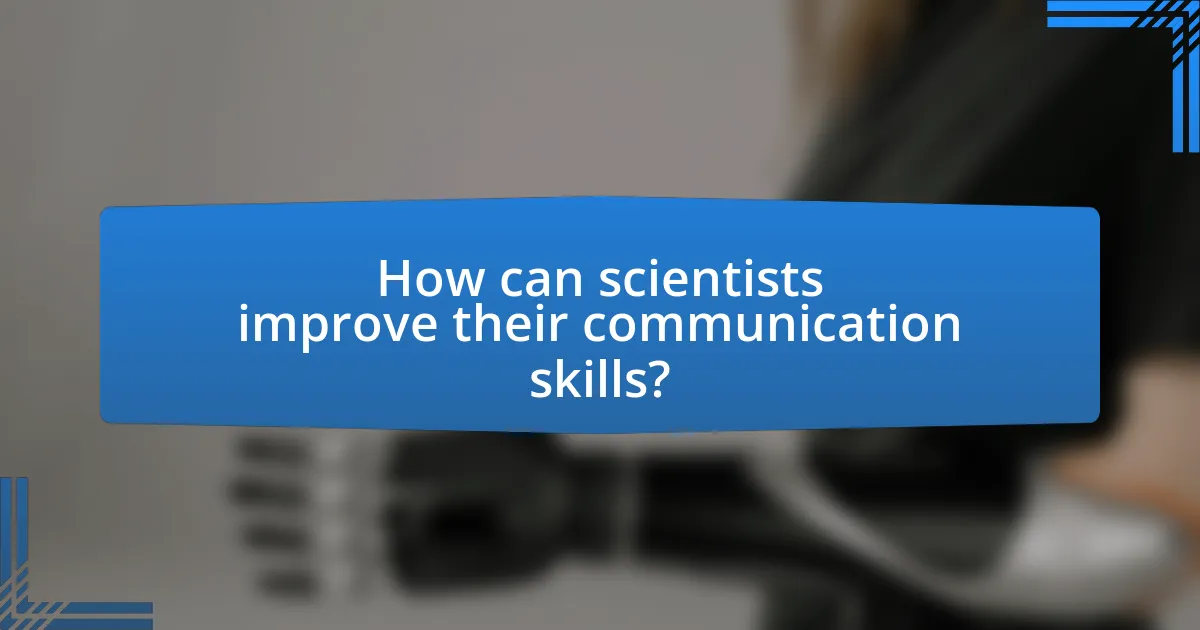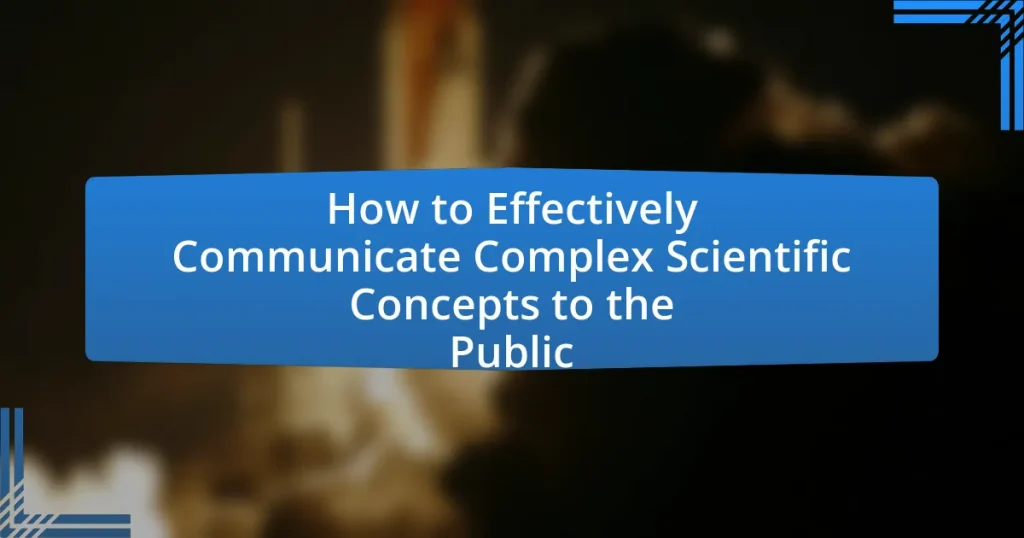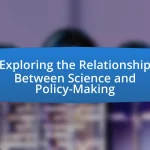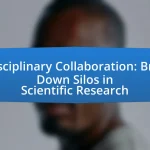The article focuses on the challenges and strategies for effectively communicating complex scientific concepts to the public. It highlights issues such as varying levels of scientific literacy, the use of technical jargon, and the impact of misinformation on public perception. The importance of clear communication in fostering public understanding, influencing policy decisions, and enhancing engagement with science is emphasized. Additionally, the article discusses practical techniques for simplifying information, the role of storytelling, and the use of various platforms and tools to improve outreach efforts. It also outlines best practices for engaging diverse audiences and measuring the effectiveness of communication strategies.

What are the challenges of communicating complex scientific concepts to the public?
Communicating complex scientific concepts to the public faces several challenges, primarily due to varying levels of scientific literacy among the audience. This disparity can lead to misunderstandings or misinterpretations of scientific information. Additionally, the use of technical jargon and complex terminology can alienate non-expert audiences, making it difficult for them to grasp essential ideas. Research indicates that only 28% of Americans can accurately define scientific terms like “gene” or “DNA,” highlighting the gap in understanding. Furthermore, emotional and cognitive biases can influence how individuals perceive scientific information, often leading to resistance against scientifically supported facts. These challenges necessitate the development of effective communication strategies that simplify complex ideas without compromising accuracy.
Why is effective communication important in science?
Effective communication is crucial in science because it ensures that complex concepts are accurately conveyed and understood by diverse audiences. Clear communication facilitates collaboration among scientists, enhances public understanding of scientific issues, and promotes informed decision-making. For instance, research published in the journal “Science Communication” highlights that effective communication can significantly improve public engagement with scientific topics, leading to better policy outcomes and increased support for scientific research.
How does public understanding of science impact policy and decision-making?
Public understanding of science significantly influences policy and decision-making by shaping public opinion and informing the priorities of policymakers. When the public possesses a strong grasp of scientific concepts, they are more likely to support evidence-based policies, as seen in the case of climate change legislation where informed citizens advocate for sustainable practices. Research indicates that higher levels of scientific literacy correlate with increased public engagement in policy discussions, leading to more democratic and transparent decision-making processes. For instance, a study published in the journal “Science Communication” by authors Kahan et al. (2017) demonstrates that individuals with better scientific understanding are more likely to engage in discussions about science-related policies, thereby impacting legislative outcomes.
What role does misinformation play in public perception of science?
Misinformation significantly distorts public perception of science by creating confusion and distrust towards scientific findings. Studies indicate that exposure to misinformation can lead to misconceptions about scientific consensus, as seen in the public’s understanding of climate change and vaccination. For example, a 2017 study published in the journal “Nature” found that individuals who encountered misinformation about vaccines were more likely to hold negative views about vaccine safety, undermining public health efforts. This distortion not only affects individual beliefs but also influences policy decisions and societal attitudes towards scientific research, ultimately hindering effective communication of complex scientific concepts.
What barriers exist in the communication process?
Barriers in the communication process include language differences, cultural misunderstandings, and cognitive biases. Language differences can lead to misinterpretation of scientific terms, while cultural misunderstandings may affect how messages are perceived based on societal norms. Cognitive biases, such as confirmation bias, can hinder the acceptance of new information, as individuals may favor information that aligns with their pre-existing beliefs. These barriers can significantly impede the effective communication of complex scientific concepts to the public, as evidenced by studies showing that clear communication strategies are essential for public understanding of science.
How do technical jargon and complexity hinder understanding?
Technical jargon and complexity hinder understanding by creating barriers to effective communication. When specialized language is used, it alienates individuals who lack the necessary background knowledge, making it difficult for them to grasp the intended message. Research indicates that 70% of adults struggle to understand health-related information due to complex terminology (Institute of Medicine, 2004). This lack of comprehension can lead to misinformation, decreased engagement, and ultimately, a failure to act on important information. Therefore, simplifying language and concepts is crucial for enhancing public understanding and ensuring effective communication of scientific ideas.
What are the psychological factors that affect public engagement with science?
Psychological factors that affect public engagement with science include cognitive biases, emotional responses, and social influences. Cognitive biases, such as confirmation bias, lead individuals to favor information that aligns with their pre-existing beliefs, which can hinder open-mindedness towards scientific findings. Emotional responses, including fear or excitement, can significantly impact how individuals perceive scientific information; for instance, fear of climate change may lead to disengagement rather than proactive engagement. Social influences, such as group identity and peer opinions, also play a crucial role; individuals are more likely to engage with science when it aligns with the values and beliefs of their social circles. Research indicates that these psychological factors can either facilitate or obstruct public understanding and acceptance of scientific concepts, as demonstrated in studies examining public reactions to health communications and environmental science.

How can scientists improve their communication skills?
Scientists can improve their communication skills by engaging in targeted training programs that focus on public speaking, writing, and visual communication. Research indicates that participation in workshops, such as those offered by the National Center for Science Education, enhances the ability to convey complex ideas clearly and effectively. Additionally, practicing communication through outreach activities, such as community talks or social media engagement, allows scientists to refine their messaging and adapt to diverse audiences. Studies show that scientists who actively seek feedback on their communication efforts are more likely to develop skills that resonate with the public, thereby increasing understanding and interest in scientific topics.
What techniques can be used to simplify complex information?
Techniques to simplify complex information include using analogies, visual aids, and breaking down information into smaller, digestible parts. Analogies relate unfamiliar concepts to familiar ones, making them easier to understand; for example, comparing the flow of electricity to water flowing through pipes. Visual aids, such as charts and infographics, can illustrate relationships and processes clearly, enhancing comprehension. Additionally, breaking down information into smaller segments allows audiences to grasp each component before integrating them into a larger context, which is supported by cognitive load theory, indicating that people learn better when information is presented in manageable chunks.
How can analogies and metaphors enhance understanding?
Analogies and metaphors enhance understanding by simplifying complex concepts and making them relatable. They bridge the gap between unfamiliar ideas and familiar experiences, allowing individuals to grasp intricate scientific principles more easily. For instance, comparing the structure of an atom to a solar system helps visualize the arrangement of electrons around the nucleus, facilitating comprehension of atomic theory. Research by Thibodeau and Boroditsky (2011) in “Metaphors We Think With: The Role of Metaphor in Reasoning” demonstrates that metaphors influence how people understand and reason about abstract concepts, confirming their effectiveness in communication.
What role does storytelling play in effective science communication?
Storytelling plays a crucial role in effective science communication by making complex scientific concepts more relatable and engaging for the audience. By framing scientific information within a narrative, communicators can evoke emotions and create connections that enhance understanding and retention. Research indicates that narratives can improve comprehension by up to 70%, as they help to simplify intricate ideas and present them in a structured format that is easier for the public to grasp. Furthermore, storytelling can bridge the gap between scientific knowledge and public perception, fostering a greater appreciation for science and its relevance to everyday life.
What are the best practices for engaging with diverse audiences?
The best practices for engaging with diverse audiences include understanding cultural differences, using inclusive language, and employing various communication methods. Understanding cultural differences allows communicators to tailor their messages to resonate with specific groups, enhancing relatability and comprehension. Using inclusive language ensures that all audience members feel represented and valued, which fosters a sense of belonging. Employing various communication methods, such as visual aids, storytelling, and interactive elements, caters to different learning styles and preferences, making complex scientific concepts more accessible. Research by the National Academies of Sciences, Engineering, and Medicine highlights that effective communication strategies significantly improve public understanding of science, demonstrating the importance of these practices in engaging diverse audiences.
How can scientists tailor their messages for different demographic groups?
Scientists can tailor their messages for different demographic groups by understanding the specific values, beliefs, and communication preferences of each group. For instance, research indicates that messages framed in a way that aligns with the cultural values of the audience, such as emphasizing community benefits for collectivist cultures or individual achievements for individualistic cultures, can enhance message receptivity. Additionally, using appropriate language complexity and visual aids can cater to varying levels of education and literacy, ensuring that the information is accessible. Studies show that when scientists customize their communication strategies based on demographic insights, such as age, education level, and cultural background, they significantly improve public understanding and engagement with scientific concepts.
What strategies can be employed to foster dialogue and interaction?
To foster dialogue and interaction, employing strategies such as active listening, open-ended questioning, and creating inclusive environments is essential. Active listening encourages participants to feel heard and valued, which enhances engagement. Open-ended questions stimulate deeper discussions and allow for diverse perspectives, facilitating a richer dialogue. Creating inclusive environments, where all voices are welcomed and respected, promotes interaction among participants. Research indicates that these strategies significantly improve communication effectiveness, as demonstrated in studies on public engagement in science communication, such as the work by Davies et al. (2018) in “Communicating Science: A Global Perspective.”

What tools and platforms can facilitate effective science communication?
Effective science communication can be facilitated by tools and platforms such as social media, blogs, podcasts, and interactive websites. Social media platforms like Twitter and Facebook allow scientists to share research findings and engage with the public in real-time, enhancing accessibility and reach. Blogs provide a space for in-depth discussions and explanations of complex topics, making them more digestible for a general audience. Podcasts offer an auditory format that can simplify intricate concepts through storytelling and interviews with experts. Interactive websites, such as those using data visualization tools, enable users to explore scientific data and concepts dynamically, fostering a deeper understanding. These platforms collectively enhance the dissemination of scientific knowledge and promote public engagement with science.
How can social media be leveraged for science communication?
Social media can be leveraged for science communication by providing platforms for scientists to share research findings, engage with the public, and foster discussions. These platforms, such as Twitter and Instagram, allow for the dissemination of complex scientific concepts in accessible formats, including infographics and short videos. Research indicates that social media can enhance public understanding of science; for instance, a study published in the journal “PLOS ONE” found that social media use significantly increased the reach and engagement of science-related content, leading to greater public interest and understanding. By utilizing hashtags and trending topics, scientists can also connect with broader audiences, making science more relatable and relevant to everyday life.
What are the advantages and disadvantages of using social media platforms?
Social media platforms offer advantages such as enhanced communication, broader audience reach, and real-time engagement, which facilitate the dissemination of complex scientific concepts to the public. For instance, platforms like Twitter and Facebook allow scientists to share research findings instantly, reaching millions and fostering discussions that can clarify intricate topics. However, disadvantages include the potential for misinformation, reduced attention spans, and the challenge of oversimplifying complex ideas, which can lead to misunderstandings. A study by the Pew Research Center in 2021 found that 64% of Americans believe that social media has a mostly negative effect on the way things are going in the country, highlighting concerns about the reliability of information shared on these platforms.
How can visual aids enhance the communication of scientific concepts?
Visual aids enhance the communication of scientific concepts by simplifying complex information and making it more accessible to diverse audiences. They facilitate understanding through visual representation, which can clarify relationships, processes, and data that may be difficult to grasp through text alone. For instance, studies show that people retain 65% of information when it is presented visually compared to only 10% when presented in written form. This demonstrates that visual aids, such as graphs, charts, and diagrams, significantly improve comprehension and retention of scientific information, thereby fostering better public engagement with scientific topics.
What role do public engagement events play in science communication?
Public engagement events play a crucial role in science communication by facilitating direct interaction between scientists and the public. These events enhance understanding of complex scientific concepts by providing accessible platforms for discussion, allowing scientists to explain their work in layman’s terms and addressing public questions and concerns. Research indicates that such interactions can significantly improve public perceptions of science, as evidenced by a study published in the journal “Public Understanding of Science,” which found that participants in engagement events reported increased interest and understanding of scientific topics.
How can workshops and community events improve public understanding of science?
Workshops and community events can significantly improve public understanding of science by providing interactive and engaging platforms for learning. These settings allow participants to ask questions, engage in hands-on activities, and discuss scientific concepts in a relatable context, which enhances comprehension. Research indicates that experiential learning, such as that found in workshops, leads to better retention of information; for example, a study published in the Journal of Science Communication found that participants in interactive science workshops demonstrated a 30% increase in knowledge retention compared to traditional lecture formats. Additionally, community events foster a sense of belonging and collaboration, making science more accessible and relevant to everyday life, thereby bridging the gap between scientific knowledge and public perception.
What are effective ways to measure the impact of science communication efforts?
Effective ways to measure the impact of science communication efforts include surveys, social media analytics, and audience engagement metrics. Surveys can assess changes in knowledge, attitudes, and behaviors among target audiences before and after communication initiatives. For instance, a study published in the journal “Public Understanding of Science” demonstrated that pre- and post-surveys effectively captured shifts in public understanding of climate change following targeted communication campaigns. Social media analytics provide quantitative data on reach, engagement, and sentiment, allowing communicators to evaluate the effectiveness of their messaging. Additionally, audience engagement metrics, such as attendance at events or participation in discussions, can indicate the level of interest and understanding generated by science communication efforts. These methods collectively offer a comprehensive approach to evaluating the effectiveness of science communication.
What practical tips can scientists follow to communicate effectively with the public?
Scientists can communicate effectively with the public by simplifying complex concepts, using relatable analogies, and engaging storytelling. Simplifying language helps avoid jargon that may confuse the audience, while analogies can bridge the gap between scientific ideas and everyday experiences. Engaging storytelling captures attention and makes the information memorable. Research indicates that effective communication increases public understanding and trust in science, as shown in studies like “Communicating Science: Tools for Scientists and Engineers” by the National Academies of Sciences, which emphasizes clarity and relatability in public discourse.
How can feedback be used to improve communication strategies?
Feedback can be used to improve communication strategies by identifying gaps in understanding and refining messaging based on audience responses. When feedback is collected through surveys, focus groups, or direct interactions, it reveals how well the audience comprehends complex scientific concepts. For instance, a study by the National Academies of Sciences, Engineering, and Medicine found that iterative feedback loops enhance public engagement and comprehension in science communication. By analyzing this feedback, communicators can adjust their language, simplify jargon, and tailor their approaches to better resonate with the audience, ultimately leading to more effective communication of scientific ideas.
What resources are available for scientists seeking to enhance their communication skills?
Scientists seeking to enhance their communication skills can utilize various resources, including workshops, online courses, and professional organizations. Workshops, such as those offered by the National Association of Science Writers, provide hands-on training in effective science communication. Online platforms like Coursera and edX offer courses specifically designed for scientists, such as “Communicating Science” by the University of California, which focuses on conveying complex ideas clearly. Additionally, organizations like the American Association for the Advancement of Science (AAAS) provide resources and networking opportunities to improve communication skills. These resources are validated by their widespread use in the scientific community and positive feedback from participants who report improved communication effectiveness.


